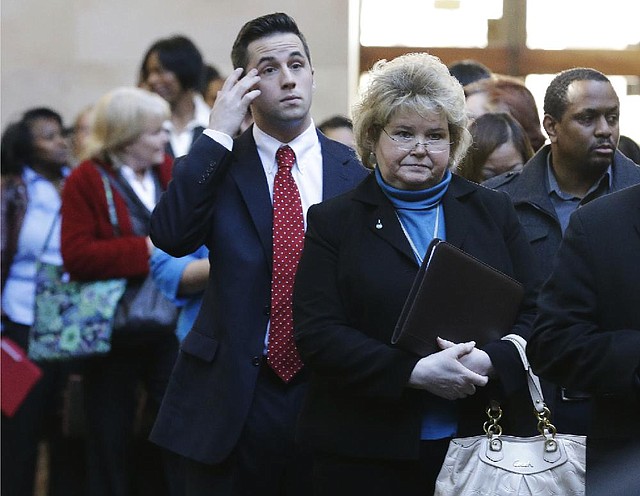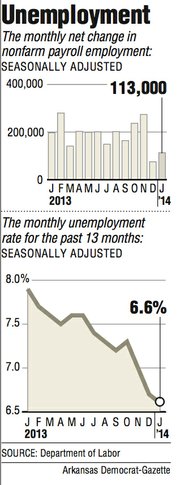Weak jobs report still offers hope
Manufacturing, construction hiring reason for optimism
In this Wednesday, Jan. 22, 2014 photo, job seekers line up to meet prospective employers during a career fair at a hotel in Dallas. January was a second straight disappointing month for U.S. job seekers, though mainly in the government and retail sectors with the end of the holiday shopping season, according to the Labor Department, Friday, Feb. 7, 2014. Only 113,000 jobs were added in January, after an even softer 75,000 gain in December. (AP Photo/LM Otero)
Saturday, February 8, 2014
WASHINGTON - Payrolls in the U.S. rose less than projected in January as retailers cut back after Christmas and government hiring fell. The unemployment rate unexpectedly fell to 6.6 percent.
A tepid gain of 113,000 jobs in January followed December’s puny increase of 75,000 - far below last year’s average monthly gain of 194,000, according to the U.S. Labor Department.
“It’s another disappointment, but it’s not anything disastrous,” said Julia Coronado, New York-based chief economist for North America at BNP Paribas and a former Federal Reserve economist. “We’re still in muddle-along territory rather than takeoff mode.”
Solid hiring last month in areas such as manufacturing and construction point to underlying strength in the economy. More people began looking for jobs in January, and they found work, lowering the unemployment rate.
Most economists say they think hiring will strengthen during 2014 as the economy improves.
Job growth “clearly has downshifted over the past two months,” said Doug Handler, chief U.S. economist at IHS Global Insight. “But we still believe the economic fundamentals remain strong.”
Investors seemed generally pleased by the figures. The Dow Jones industrial average rose 165 points.
Friday’s jobs data suggest the economy may slow in the first few months of the year from its robust 3.7 percent annual pace in the second half of 2013. The hiring figures follow other signs of a possibly softening economy. A survey of manufacturing firms showed factory expansion slowed last month. A measure of forthcoming home sales fell.
The jobs report offered some hints that hiring could return to last year’s healthier levels in coming months.
To begin with, the unemployment rate is at its lowest point since October 2008, just as the financial crisis was worsening. The rate fell be-cause many of the unemployed found work. And the influx of people seeking jobs - a sign of optimism - was an improvement from December. In that month, the unemployment rate fell only because about 350,000 people stopped looking for work and were no longer counted as unemployed.
Another positive sign is manufacturers, construction firms and mines added a combined 76,000 jobs last month - the most since January 2006. Goods-producing employers tend to hire only when they’re confident in the economy.
“You rarely see expansions in these industries without the economy being in fairly healthy shape,” said Gary Burtless, an economist at the Brookings Institution.
Home sales and construction are rising, a trend economists expect to continue. If it does, more construction jobs should lead to more retail spending as people furnish homes.
The effect of government tax increases and spending cuts, which dragged on growth last year, should diminish sharply in 2014. And despite recent turmoil in several emerging economies, the global economy appears in better shape than it has been in the past three years, when Europe’s financial crisis threatened U.S. growth.
“There’s nothing really holding growth back,” said Paul Ashworth, an economist at Capital Economics. Most economists expect the U.S. economy to expand 2.5 to 3 percent this year, up from 1.9 percent in 2013.
Several industries shed jobs last month, but the losses were likely temporary. Retailers cut nearly 13,000 jobs, but that followed three months of huge gains.
And government jobs dropped by 29,000. Local governments shed 11,000 jobs, partly because bus drivers and cafeteria workers were temporarily laid off when winter weather closed schools. The federal government cut 12,000, including 8,500 at the U.S. Postal Service.
Economists don’t expect such deep cuts to continue. State and local tax revenue has recovered after plunging during the recession.
“The pullback in January [by governments] was a bit of a surprise,” said Patrick O’Keefe, director of economic research at CohnReznick, an accounting and consulting firm.
Cold weather likely held back hiring in December, but the effect seemed to fade in January. That’s likely because the government’s survey of business hiring was conducted in mid-January, in between some of the worst winter storms.
Construction firms added 48,000 jobs in January, rebounding from a loss of 22,000 in December that likely reflected unseasonably cold temperatures. Construction work typically stops if it’s too cold.
But other firms unaffected by the weather are adding jobs.
One such company is Agri-Industrial Plastics Co., based in Fairfield, Iowa, which makes fuel tanks and other parts for tractors, snowmobiles and ATVs. It sells to companies such as John Deere, Yamaha and Arctic Cat.
Chief Executive Officer Lori Schaefer-Weaton said she foresees healthy sales growth in 2014. The recovery in home sales and construction has created more landscaping work and increased sales of riding lawnmowers and other equipment. Most of the company’s manufacturing customers are optimistic about sales this year.
She’s looking to add 12 jobs to her 170-person staff. The company is seeking salesmen customer service workers and quality-control engineers.
“So far, what we’re seeing is looking good,” she said. “Hiring good people is at the top of my to-do list, every day.” Information for this article was contributed by Christopher S. Rugaber, Paul Wiseman and Josh Boak of The Associated Press and Shobhana Chandra of Bloomberg News.
Business, Pages 27 on 02/08/2014

